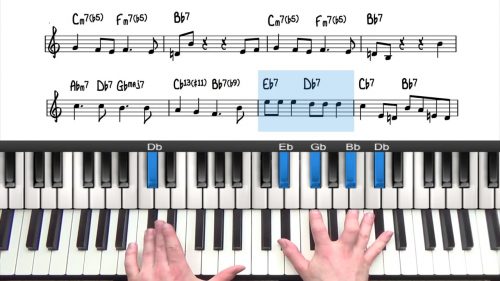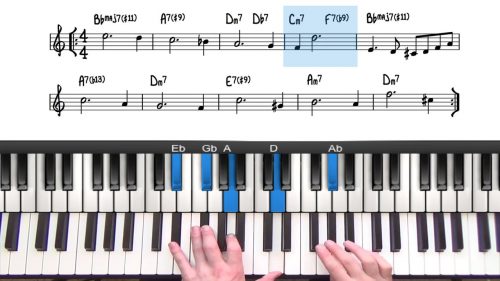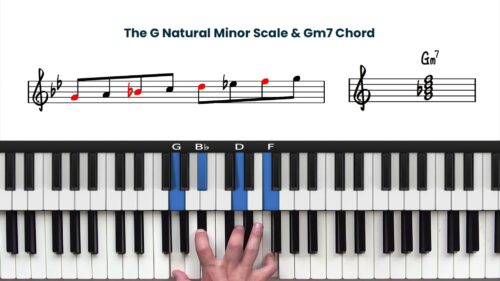“I’ll Be Home For Christmas” Beginner Version
In this lesson we arrange the famous festive tune “I’ll Be Home For Christmas”.
We have a more advanced arrangement of this tune later on in the course but if you are new to jazz piano first start with this lesson.
7th Chords & Voice Leading
In this lesson we create a full arrangement using 7th chords and we pay special attention to the voice leading of b7ths falling to 3rds in the 25 and 251 progressions.
If you’re new to jazz piano, this is an excellent tune to study and apply the 251 progression and how it is used in jazz standards.
Suspended Chords & Voicings
In this lesson we explore the foundation of suspended harmony. Sus chords are often used to delay the sense of resolution in a 251 progression and they are commonly found in the Christmas jazz repertoire.
You can find an in-depth study on Sus chords in the related lesson section below where we explore more advanced applications of this type of voicing.
Practice Tips
-
This tune follows an ABAC Form. Memorising the form of tunes will help to speed up the memorisation process. Check out this lesson on Common Jazz Forms
-
Study the #11 ending that is used in this arrangement. When finishing a tune, we can play a major chord a half step higher than the final chord to delay the sense of resolution.
-
Adding the #11, or outlining the notes from the Lydian mode, adds a floating, mysterious quality which is well-suited to the ending of a jazz ballad arrangement.







Thank you for this nice simple version. I am not really a beginner but it is always nice to start with simple version and expand as skills develop. That helps me build a repertoire faster.
Thanks Don.
As per your previous request, I have started a new course with simpler arrangements: pianogroove.com/jazz-piano-lessons/beginner-jazz-piano-arrangements/
I will be adding more lessons here that just contain simple voicngs.
Cheers and happy new year!
Hayden
Wonderful Hayden. A great lesson were you show what to play with the following trancription. Makes it more easy to study what is going on while still having funn playing the tune. Structure thats what its all about. It is jazz and jazz is not easy. Thanks. Great lesson. Let them keep comming like that.
Thanks Jimmy, really glad to hear you enjoyed the lesson!
Hayden
Wow… that ending you did for this song… really beautiful melodies there Hayden. :) I hope I get to improve my version hahah, I’m only on my first attempt currently . Thanks very much for this lovely lesson.
Thanks Tina, really glad you enjoyed the tutorial.
Cheers!
Hayden
Hi Hayden, I asked you previously about the run of Dbmaj9(#11) to Cmaj9(#11) and your explanation here helps. Thanks
Hi Eric 👋🏻
Good question!
When ending a tune, we can finish with a major chord a half step higher, run that chord up the piano, and then resolve into the I Chord. This delays the sense of resolution into the final chord, and surprises the listener. It’s a nice trick that we can apply to any jazz standard.
In this example, we finish with a C Major chord, and so I play a major chord a half step higher which is Db Major 7.
This also works well when the final chord finishes with the root in the melody, as it does in this tune. Notice that the final melody note is a ‘C’ over a C Major chord.
By instead playing a Dbmaj7, that ‘C’ in the melody becomes the major 7th of Db, and then we can then resolve into any note or extension of C Major, I like to run up the keyboard with Db Major 7 Arpeggio, and then resolve into C Major using a ‘D’ which is the 9th.
The final part of your question is the #11 colour that we apply to both chords. Whenever we play a major chord, we can add the #11 which creates a ‘floating quality’. In both chords I outline the #11 in my arpeggios.
For Dbmaj7, the #11 is the note ‘G’ and for Cmaj7, the #11 is the note ‘F#’. By including these notes in the arpeggios running up the keyboard, it creates a mysterious quality to end the tune.
I hope this explanation help Eric.
As an exercise, try applying this to another tune that you are working on, perhaps a tune that is not in C Major, so that the chords are different. Instead of resolving into the 1 chord, play the major 7th chord a half step up and add the #11 colour. Then finally resolve into the I chord.
Have fun with this stuff and let me know if you have any further questions.
Cheers,
Hayden
Hello Hayden,
I would like to learn this song and I see basically two ways to tackle it.
Method A. Work primarily with the transcription, learning the right hand, learning the left hand, then putting them together section by section. A “classical” approach.
Method B. Work with the chord sheet and the video tutorial but learning both hands together thus facilitating learning of the harmony.
Your thoughts?
I have been playing jazz piano for 3 years with your platform and a teacher. Have so far learned Just Friends, Someone to Watch Over Me, Summertime, The Nearness of You and The Days of Wine and Roses, primarily using method A.
Thanks and great arrangements btw,
Guy Philippe
Hi Guy 👋🏻
Good question!
I would advise against the using the transcription. I have never used transcriptions in my jazz education and it is best to reduce and remove our reliance on reading full notation when playing jazz piano.
Your “Method B” is the better approach and I certainly advise using lead sheets until we have memorised the tune. We can further reduce our reliance on lead sheets by memorising the form and chord changes of the song.
I had forgotten to add the lesson chapters to the lesson, but you will now see the chapter markings.
I have created the chapter markings around the form of the tune. You will see that the chapters are “1st A Section”, “The B Section” etc….. and this is very important information to speed up the process of memorisation when learning jazz standards.
Incidentally, I used this tune for the focus of 2 of my recent Live Seminars on “learning jazz standards” and “reharmonising jazz standards”. Check those 2 seminars out here:
pianogroove.com/live-seminars/arranging-jazz-standards/
pianogroove.com/live-seminars/how-to-reharmonise-melody/
The first seminar referenced above is particularly relevant to your question where we discuss memorising the form, the melody, the lyrics, and the chord changes.
When we do this, we have a lot more freedom to interpret the tune and play different voicings each time. When reading from a full score, the temptation is there to just read what is written which can inhibit the creative process.
By understanding the tune follows an ABAC form, we have instantly identified that half of the tune follows the exact same chord changes, and so when we have memorised the chords from the 1st A Section, we have in fact memorised half of the tune.
Take a look at the seminars above where I explain this in much greater detail, and if you have any further questions you can post here, or on the seminar pages.
I hope this helps Guy and have fun with this tune. It’s a lovely song to play around with and reharmonise as I do in the 2nd live seminar referenced above.
Cheers,
Hayden
Thanks, this helps for sure.
Great stuff, thanks Guy.
Enjoy watching the related seminars – they should give you lots of ideas to work on this tune.
Cheers!
Hayden
Ok I have watched the first seminar. Very interesting.
One clarification: so if you are recommending to work only with the lead sheet, why do you provide both the lead sheet and the transcription for many of the jazz standards? How should the transcriptions be used?
Personally, I find them useful. Sometimes it is difficult to pick up the voicings and how they are played when watching the video tutorial (sometimes too fast).
Thanks,
Hi Guy,
The transcriptions are there as an aid if needed. They were initially provided after many requests from our students.
By all means use them to pick the voicings out as you say, the danger can be to fall into the trap of reading the transcription in the same way that we would read a piece of classical music. I highlighted the problem of this in my last comment.
By always reading transcriptions we often neglect learning and memorising the voicing shapes on the keyboard, and fully analysing what we are playing. These 2 things are very important to achieve a greater sense of freedom when playing jazz.
For some students they might just want to play something jazzy sounding, and not have much interest in memorising the construction of the voicings and the harmonic relationships taking place as the chords move from one to the next. In this case the transcriptions are the quickest route to get the desired result. So it very much depends on your own goals.
As mentioned I have never used transcriptions to learn a new song, I find that a lead sheet, and in particular a list of nice recordings is the best way to learn a song in a way that opens up our creativity. I can’t emphasise enough the importance of listening to lots of versions of any song you are working on – Spotify is great for this – as that way we are exposing ourselves to lots of new ideas and inspiration that we can incorporate into our own arrangement of the song.
I hope this helps Guy and let me know if you have any further questions.
Cheers,
Hayden
Hi Hayden,
Very clear, thanks so much.
Guy Philippe
Hi Hayden
On the chord chart for this song bar 13 has two upper C notes. You play D – which is correct?
Thanks
Grahame
Hi Grahame,
Good spot!…. that is a typo.
I will correct the document and re-upload.
Thanks for letting me know about this.
Cheers,
Hayden
Just started course, Xmas-Jazz. First song, I’ll Be Home For Xmas, a symbol, under each measure looks like a word LED________, What does it mean?
Hi Harry,
Good question.
That says “Ped” which is short for pedal ie. the sustain pedal (the right hand pedal when sat at the piano).
You will hear that I use the sustain pedal quite liberally in this arrangement which creates a nice smooth sound when playing ballads such as this one.
I hope that helps and let me know if you have any further questions.
Cheers,
Hayden
Hi Hayden, the 2nd chord Eb diminished. You know I always trying to figure out the chords in relation to the key and i don’t understand this chord. Is it substituting for another chord or a five of five of something (smile). Let me know. Thanks. I’m also starting on the Christmas jazz songs.
Hi Lonnie,
Great question.
It’s common to find diminished chords leading into a minor chord from a half step above. In this example Ebdim7 to D-7. Another example would be the first 4 bars of “Embraceable You” where we have Gmaj7 / Bbdim7 / A-7 / D7.
If we analyse the notes, it’s just the bottom 2 notes that are different from the subsequent minor 7 chord, in this case we have the Eb and Gb which both drop by a half step to become D and F of D-7, and the upper 2 notes remain the same on both chords.
In terms of the harmonic relationship here I’m not sure aside from the similarities outlined above. I will forward this to Tuomo now and see if he can shed some light on this for us.
He has a much better understanding of functional harmony than I do.
Cheers,
Hayden
Hi Lonnie and Hayden, the Ebdim –> D-7 is a common harmonic movement, a “descending diminished”.
The reason why Ebdim sounds good and resolves nicely to D-7 is that the Ebdim is in fact, like Lonnie guessed, a V of V (see attahcment). As you can see, the Ebdim chord tones are the chord tones of a D7, the dominant to G7, V of this key Cmajor.
Now, the reason it sounds good when resolving to D-7 is because of the II V connection; due to the strong harmonic connection between D-7 and G7, we can resolve D7 to D-7, as it’s followed most likely by G7, like in this song.
I hope this answered your question :)
More on the subject of diminished, check out the following video startinf ca. 2:50:
pianogroove.com/jazz-piano-lessons/chromatic-25-progression/
-Tuomo
Brilliant, thanks Tuomo – that makes perfect sense.
Cheers,
Hayden
Hi This is my first lesson and I’m a beginner at piano…I have tried getting the first roll to sound as you do but simply can’t get it to sound right…I first play C as starting note and then try left hand C then roll E GA C ending note sounding only C…
When you do it it sounds as more notes should be sounding…a bit sad to give up on the first chord…Do you have any tips or insight??
Hi Micke,
Good question.
The left hand is playing C with the pinky, then G with the index finger, and then E with the thumb once the right hand lifts up from this note. Practice this on it’s own rocking from pinky finer, to index finger, then to the thumb. Aim to play this smoothly and in control. You can also use the pedal – more on this below.
For the right hand practice playing the 4 notes together E-G-A-C, and then try to roll your hand slightly so that you play the notes bottom to top.
Another important things is to play with the sustain pedal (the pedal on the right hand side) and this will smooth out the sound of the chord as you roll up with both hands.
If you are new the piano, it can take some time to build up the hand and finger strength, but just practicing a little each day is the key. Don’t burn yourself out on the first chord, instead continue with the next chords and revisit it the next day.
You will find that when you come back to the piano, your finger strength improves. A lot of the progress happens when we are away from piano, a bit like going to the gym and working out; we don’t see the improvements instantly, instead it happens gradually.
I hope that helps Micke and let me know if I can help further.
Cheers,
Hayden
Thanks Hayden, I have roughly the same question as Micke. I am struggling to get beyond playing all the notes simultaneously. Try as I might, I can’t seem to get the sequence of notes you roll that produce such a great sound. I will keep working on the notes as chords and practice rolling them.
😳
Started out on the YouTube version, then found the more advanced version here on the site and thought that was only one. Learned some of that and finally found this easy version. Should have started with the easy one. Good news is I have a lot to work with. Bad news is I spent too much time on this tune. Did learn a lot.